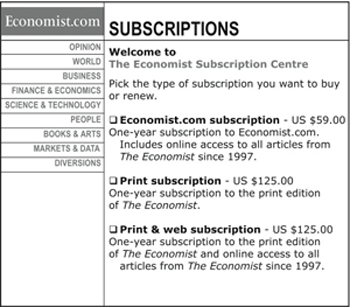Imagine that your prospects didn’t hesitate, not even for one second, to pay your price. That it would be – in fact – a no-brainer.
Don’t believe that’s possible? Then stop here.
However, if you don’t want to leave money on the table and if you don’t want to miss my free gift at the end of this article, you might want to keep reading.
How do I know that most planners make this mistake?
Because they don’t know the psychology that goes with the setting of profitable prices for their services.
And no, the mistake is not that you charge too little (though that is a common mistake as well).
And no, the mistake is also not that most planners sit back and think to themselves: “Hmmm, what price should I pick?” And then they pull a number out of a hat and that’s it.
The mistake is to have only one price for your service.
Why? Because if you have only one price, you are not making it easy for your potential clients to decide to do business with you. You see, most of the time your prospects generally can’t understand or accurately explain why they want to hire a financial planner. The truth is, when you help them to decide to do business with you, it saves them time, money, and energy.
That’s why you want to set a smart price that will turn your offer into a no-brainer. Luckily, financial planners are by definition smart people. And, simply put, I believe smart planners want to set smart prices.
And before you wonder if I’m going to discuss a commission-based model, a fee-only based model or any other type of revenue model in our industry, I’d like to be straightforward with you on this one: I’m not. Because I believe “models” aren’t that important. In fact, what I do believe is that if financial planners serve their clients in an ethical, honest and sincere way, it doesn’t matter which type of revenue model you choose.
And if you think your customers do care about your “model”, well, you’d better read this.
What You Can Learn from Bread Machines When It Comes to Pricing
Years ago I read Predictably Irrational, Revised and Expanded Edition: The Hidden Forces That Shape Our Decisions by Dan Ariely. For the planners who haven’t read this bestseller; it’s about human irrationality and how we can predict this irrationality when it comes to decision-making.
And for those who don’t know; people are far less rational than standard economic theory assumes. Because sixty years of reseach has shown that 95% of our decisions are irrational.
That’s quite unbelievable when you read those statistics for the first time. Because most of the time we – as logical, analytical and rational financial planners – tend to believe our decisions are, indeed, rational.
But…………..they’re not. Just read this short irrational story about bread machines and I’ll show you.
You might have heard this classic story about how Williams Sonoma introduced a bread machine into the market and why they thought it would sell extremely well.
However, long story short, it didn’t. It didn’t sell well at all.
That’s why they decided to introduce a new bread machine. A bread machine that cost 50% more than the original bread machine. The first bread machine cost $275 and the new and second machine cost $429.
Guess what happened?
Sales of the first bread machine (the cheapest one) almost doubled. What happened was that people saw this as a “trade off effect”. They didn’t want to buy the most expensive option, so they decided to buy the cheaper option.
Why?
Because the most expensive option is seen as a price-anchor, making the first bread machine appear cheaper and look like “a deal”. People rationalize purchasing the less expensive option by avoiding the most expensive option.
There is only one problem with this strategy: it kills your revenues. What’s worse is that people tend to haggle the cheapest version down further.
How to Fix Pricing Mistakes
As Dan Ariely points out in Predictably Irrational, it’s all about relativity. People not only tend to compare things with one another but also tend to focus on comparing things that are easily comparable – and avoid comparing things that cannot be compared easily.
What do I mean?
Take a look at this ad from The Economist:
The first option – the Internet subscription – for $59 seems reasonable.
The second option – the $125 print subscription – seems a bit expensive, but still reasonable.
But then, the third option: a print and Internet subscription for $125.
Huh?
Is that a typo?
If it’s true, who on earth would buy the print option alone when both the Internet and print subscription are offered for the same price?
What’s really happening is that the (very smart) Economist-marketers probably WANT people to skip the cheapest option.
As Ariely points out:
The marketing wizards know something important about human behavior: humans rarely choose things in absolute terms. People don’t have an internal value meter that tells us how much things are worth. Rather, we focus on the relative advantage of one thing over another, and estimate value accordingly.
And in this case, you may not have known whether the Internet-only subscription at $59 was a better deal than the print-only option at $125. But you certainly knew that the print-and-internet option for $125 was better than the print-only option at $125.
In fact, you could reasonably deduce that in the combination package, the Internet subscription is free!
How You Can Use This In Your Financial Planning Service
If you are like me, you now might have an idea how you could use this in your own financial planning service.
You might think, hey, I’m going to copy this. And this is how it might look:
Offer #1
Financial Planning: $2,497 plus monthly fee $97
Offer #2
Wealth Management: 1% of AUM
Offer #3
Wealth Management & Financial Planning: 1% of AUM
The first offer seems ok. The second option seems a bit expensive, but still reasonable. But then your prospect reads the third option before his eyes run back to the previous options.
“Who wants to buy stand alone financial planning, your prospect wonders, when wealth management PLUS financial planning is offered for the same price?”
The third option is in fact, a no-brainer.
What’s going on here? Most of your prospects don’t know what they want unless they see it in context. They don’t know what kind of racing bike they want – until they see a champ in the Tour de France ratcheting the gears on a particular model. They don’t know what kind of speaker system they like – until they hear a set of speakers that sounds better than the previous one.
Your prospect doesn’t know what price they want to pay – until they see the other options where they “only” have to pay 1% for wealth management PLUS financial planning. Because then it clearly looks superior.
And I hear you think: that’s great Ronald, but …
What if I’m an Hourly Planner or a Planner with a Monthly Retainer Model?
Then picture yourself grabbing a cab. Picture yourself looking at that taxi meter. Don’t you hate watching the taxi meter going up, knowing that every extra inch of the way is costing you?
Why do people hate this?
It’s because of the pain people are suffering. Not physical pain of course, but rather activation of the same brain areas associated with physical pain. The same goes for some of our revenue models.
You see, your clients are not weighing their current gratification vs. future gratifications. They experience an immediate pang of pain when they think of how much they have to pay.
So, suppose you are an hourly-rate financial planner, then try to honestly answer this question: Do you believe serving your client by the hour minimizes pain? Or is it like the taxi meter?
It’s obvious, right?
But hey, not to worry. Because you might want to consider why AOL switched from pay-per-hour Internet service to pay-per-month. And that – because of doing this – they got a flood of new subscribers.
And it’s not strange. You see, science tells us that people love to prepay for things or pay a flat rate for things.
Why?
Because it mutes the pang of pain.
Marketers have realized this for years, and they have responded with offers designed to minimize pain associated with buying their products. Netflix crushed its video rental competitors in part by its “all-you-can-watch” price strategy. Cruises have surged in popularity in part because they deliver a vacation experience for a fixed price.
In each case the marketer offers a single, relatively attractive price that removes additional pain from the buying experience.
In our industry, the single price (flat fee or all in fee) is actually higher than the amount your client spends on your advice. Nevertheless, the all-inclusive fee is likely to appeal to many of your clients.
Why?
Because it mutes the pang of pain.
So, why don’t you try to avoid multiple individual pain points in your financial planning service?
There are several options. You might want to experiment with a single-price approach for your services such as an annual fee or all in fee instead of the hourly-rate. That simpler pricing approach may boost not only sales. As some people will pay a premium for pain avoidance, profit margins may boost as well.
However, if you don’t want to do the hard work yourself, but instead, want to use a proven price-strategy that – regardless of your revenue model – works to sell the type of financial planning service you want to sell, the only thing you have to do is to answer the following question:
What is your biggest problem when it comes to the price of your financial planning service?
Please, answer this question by leaving your comment – here below – and you’ll receive a free PDF with The Simple Price Tweak That Will Get You More Clients Right Now.
Thank you for your comment.
Let’s make financial planning matter,
Ronald Sier


